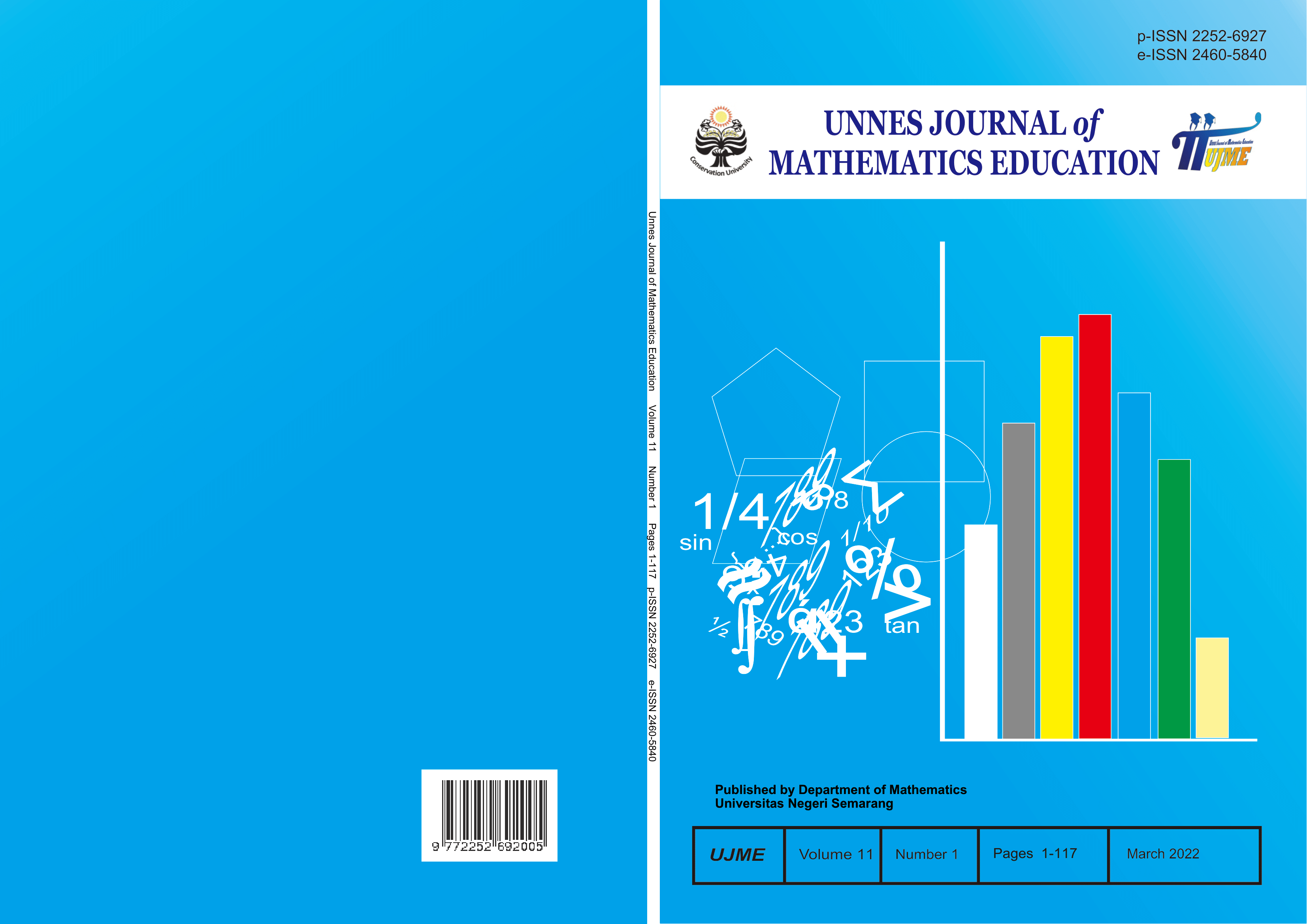The Development of Mathematical Worksheet based on Surrounding Environment with Problem Based Learning Model to Improve Creative Thinking Ability
##plugins.themes.academic_pro.article.main##
Abstract
This research aims to develop mathematical worksheet product based on surrounding environment in the problem based learning in flat-side space material and to improve creative thinking ability. Using Research and Development with 4D-Thiagarajan model modified 3D (consist of define, design and, develop). The result show that student worksheet is valid, easy to understand, and effective to improve creative thinking ability. The worksheet is valid with an average percentage of 88.60%. Next, the worksheet is easy to understand with a percentage of 83% using a practice tests with a cloze test. Meanwhile, the worksheet can improve creative thinking ability through the paired T-test and right-tailed T-test which was strengthened by the N-gain test with a result of 0.596 on the medium criteria. The worksheet is packaged an atrractive presentation targeting 8th grade and has received e-copyright by Electronic Intellectual Wealth General Directory.
##plugins.themes.academic_pro.article.details##
References
Akbar, S. (2013). Instrumen Perangkat Pembelajaran. Bandung: PT Remaja Rosdakarya.
Alismail, H. A., & McGuire, P. (2015). 21st century standards and curriculum: Current research and practice. Journal of Education and Practice, 6(6), 150-154
Anditiasari, N., Pujiastuti, E., & Susilo, B.E. (2021). Systematic literature review: pengaruh motivasi terhadap kemampuan berpikir kreatif matematis siswa. AKSIOMA: Jurnal Matematika dan Pendidikan Matematika, 12(2), 236-248
Astuti, A., & Sari, N. (2017). Pengembangan Lembar Kerja Siswa (Lks) Pada Mata Pelajaran Matematika Siswa Kelas X Sma. Jurnal Cendekia : Jurnal Pendidikan Matematika, 1(2), 13–24. https://doi.org/10.31004/cendekia.v1i2.16
Balitbang Kemendikbud. (2019). Pendidikan di Indonesia : Belajar dari Hasil PISA 2018. Jakarta:Balitbang Publishing
Cahyono, A. E. Y. (2017). Pengembangan Perangkat Pembelajaran Problem- Based Learning Berorientasi pada Kemampuan Berpikir Kreatif dan Inisiatif https://journal.uny.ac.id/index.php/pythagoras/article/view/14052/pdf
Chalkiadaki, A. (2018). A Systematic Literature Review of 21st Century Skills and Competencies in Primary Education. International Journal of Instruction, 11(3), 1-16. https://doi.org/10.12973/iji.2018.1131a
Choiri, M. M. (2017). Upaya Pemanfaatan Lingkungan Sekitar Sebagai Sumber Belajar Anak. Refleksi Edukatika : Jurnal Ilmiah Kependidikan, 8(1). https://doi.org/10.24176/re.v8i1.1793
Florida, R., Mellander, C., & King, K. (2015). The Global Creativity Index 2015. Toronto: Martin Prosperity Institute. Retrieved from http://martinprosperity.org/media/Global-Creativity-Index-2015.pdf
Hake, R.R. (1999). Analyzing change/gain scores. Wooodland Hills: Dept of Physics, Indiana University.
Handayani, U. F., Sa’dijah, C., & Susanto, H. (2018). Analisis Kemampuan Berpikir Kreatif Matematis Siswa SMP Dalam Menyelesaikan Soal Adopsi ‘PISA.’ Jurnal Math Educator Nusantara: Wahana Publikasi Karya Tulis Ilmiah Di Bidang Pendidikan Matematika, 4(2), 143-156. https://doi.org/10.29407/jmen.v4i2.12109
Hasanah, S. I. (2014). Sumber Belajar Matematika dari Lingkungan Alam Sekitar Berbasis Pondok Pesantren. Interaksi:Jurnal Kependidikan, 9(1), 28–31.
Hasbullah & Wiratomo, Y. (2015). Metode, Model, dan Pengembangan Model Pembelajaran Matematika. Jakarta:Unindra Press.
Lestari, H., Pamungkas, A. S., & Alamsyah, T. P. (2019). Pengembangan Lembar Kerja Siswa Eksploratif Berkonteks Budaya Banten pada Mata Pelajaran Matematika di Sekolah Dasar. Prisma Sains : Jurnal Pengkajian Ilmu Dan Pembelajaran Matematika Dan IPA IKIP Mataram, 7(1), 48–59. https://doi.org/10.33394/j-ps.v0i0.1401
Moma, L. (2015). Pengembangan Instrumen Kemampuan Berpikir Kreatif Matematis Untuk Siswa Smp. Delta-Pi: Jurnal Matematika Dan Pendidikan Matematika, 4(1), 27–41 retrieved from http://ejournal.unkhair.ac.id/index.php/deltapi/article/view/142
Muhid, A. (2019). Analisis Statistik:5 Langkah Praktis Analisis Statistik dengan SPSS for Windows. Sidoarjo:Zifatama Jayawara. Diakses 10 Oktober 2021 SPSS for Windows. Sidoarjo:Zifatama Jayawara. Diakses 10 Oktober 2021 https://books.google.co.id/books?hl=id&lr=&id=K3IDEAAAQBAJ&oi=fnd&pg=PA1&dq=uji+t+berpasangan+spss&ots=nK4HqDD6zQ&sig=VmSax8gVRM9qTEfQ0vqKQWWZgUM&redir_esc=y#v=onepage&q&f=false
National Education Association. (2012). Preparing 21st Century Students for a Global Society: An Educator’s Guide to the “Four Cs.” Accessed 11st December 2020 retrieved from https://pdf4pro.com/view/an-educator-s-guide-to-the-four-cs-nea-org-39c8.html
Neka, I. K., Marhaeni, A. A. I. ., & Suastra, I. W. (2015). Pengaruh Model Pembelajaran Inkuiri Terbimbing Berbasis Lingkungan Terhadap Keterampilan Berpikir Kreatif Dan Penguasaan Konsep Ipa Kelas V Sd Gugus Viii Kecamatan Abang. Jurnal Program Pascasarjana Universitas Pendidikan Ganesha Program Studi Pendidikan Dasar, 5(1), 1–11.
Niam, M.A. (2020). Pengembangan Bahan Ajar Matematika Bernuansa Science, Technology, Engineering, and Mathematics untuk Meningkatkan Kemampuan Koneksi Matematis pada Problem Based Learning. (Undergraduate Thesis). Universitas Negeri Semarang. Semarang.
Nismawati, N., Nindiasari, H., & Mutaqin, A. (2019). Meningkatkan Kemampuan Berpikir Reflektif Matematis Melalui Model Pembelajaran Problem Based Learning Berbasis Lingkungan. JPPM (Jurnal Penelitian dan Pembelajaran Matematika), 12(1), 78-93.
Pane, A., & Dasopang, M. D. (2017). Belajar dan Pembelajaran. FITRAH:Jurnal Kajian Ilmu-Ilmu Keislaman, 3(2), 333-352 https://doi.org/10.24952/fitrah.v3i2.945
Peraturan Menteri Pendidikan dan Kebudayaan Republik Indonesia Nomor 22 Tahun 2016 Tentang Standar Proses Pendidikan Dasar dan Menengah (Decree of The Indonesian Minister of Education and Culture Number 22, 2016)
Prastowo, A. (2015). Panduan Kreatif Membuat Bahan Ajar Inovatif. Yogyakarta:Diva Press.
Puspendik Kemdikbud. (2019). Persentase Siswa yang Menjawab Benar Mata Ujian Matematika Jenjang SMP/MTs Tahun Pelajaran 2018/2019. Retrieved from https://hasilun.puspendik.kemdikbud.go.id/
Schleicher, A. (2019). PISA 2018: Insights and Interpretations. Paris:OECD Publishing.
Sudijono, A. (2008). Pengantar Statistik Pendidikan. Jakarta:Raja Grafindo Persada.
Sugiyono. (2016). Metode Penelitian Pendidikan. Bandung:Alfabeta.
Sumar, W.T. & Razak, I.A. (2016). Strategi Pembelajaran Kurikulum Berbasis Soft Skill.Yogyakarta:Deepublish.
Tambychik, T., & Meerah, T. S. M. (2010). Students’ difficulties in mathematics problem-solving: What do they say?. Procedia-Social and Behavioral Sciences, 8, 142-151.
Thiagarajan, S., Semmel, D.S., Semmel, M.I. (1974). Intructional Development or Training Teacher of Exceptional Children. University of Minnesota.
Undang-Undang Republik Indonesia Nomor 20 Tahun 2003 Tentang Sistem Pendidikan Nasional (Act of The Republic of Indonesia Number 20, 2003).
Yew, E. H. J., & Goh, K. (2016). Problem-Based Learning: An Overview of its Process and Impact on Learning. Health Professions Education, 2(2), 75–79. https://doi.org/10.1016/j.hpe.2016.01.004
